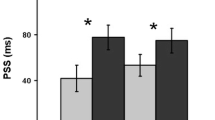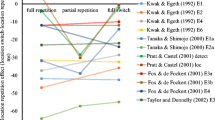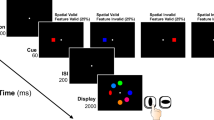Abstract
Briand (J Exp Psychol Hum Percept Perform 24:1243–1256, 1998) and Briand and Klein (J Exp Psychol Hum Percept Perform 13:228–241, 1987) demonstrated that spatial cueing effects are larger for detecting conjunction of features than for detecting simple features when spatial attention is oriented exogenously, and not when attention is oriented endogenously. Their results were interpreted as if only exogenous attention affects the posterior spatial attention system that performs the feature binding function attributed to spatial attention by Treisman’s feature integration theory (FIT; 1980). In a series of 6 experiments, we attempted to replicate Briand’s findings. Manipulations of distractor string size and symmetry of stimulus presentation left and right from fixation were implemented in Posner’s cueing paradigm. The data indicate that both exogenous and endogenous cueing address the same attentional mechanism needed for feature binding. The results also limit the generalisability of Briand’s proposal concerning the role of exogenous attention in feature integration. Furthermore, the importance to control the effect of unintended attentional capture in a cueing task is demonstrated.





Similar content being viewed by others
Notes
As endogenous cueing calls for higher cognitive processes, endogenous attentional shifts require more time than the automatic exogenous attentional shifts. As in a first pilot experiment we encountered a large amount of errors in the endogenous condition with a short SOA of 100–200 ms, we enlarged cue–target interval to 800 ms.
In Kawahara and Miyatani (2001), cueing effects were 56–79% smaller, respectively, for the feature and conjunction condition for their uninformative peripheral condition compared to their informative peripheral condition.
References
Briand, K. A. (1998). Feature integration and spatial attention: More evidence of a dissociation between endogenous and exogenous orienting. Journal of Experimental Psychology: Human Perception and Performance, 24, 1243–1256.
Briand, K. A., & Klein, R. M. (1987). Is Posner’s Beam the same as Treisman’s “Glue”?: On the relation between visual orienting and feature integration theory. Journal of Experimental Psychology: Human Perception and Performance, 13, 228–241.
Eriksen, C. W., & Colegate, R. L. (1971). Selective attention and serial processing in briefly presented visual displays. Perception and Psychophysics, 10, 321–326.
Eriksen, C. W., & Hoffman, J. E. (1972). Temporal and spatial characteristics of selective encoding from visual displays. Perception and Psychophysics, 12, 201–204.
Eriksen, C. W., & St. James, S. D. (1986). Visual attention within and around the field of focal attention: A zoom lens model. Perception and Psychophysics, 40, 225–240.
Gibson, B. S., & Bryant, T. A. (2005). Symbolic control of visual attention: Involuntary orienting is contingent on symbol processing. Perception and Psychophysics, 67, 749–758.
Godijn, R., & Theeuwes, J. (2003). The relationship between exogenous and endogenous saccades and attention. In J. Hyönä, R. Radach, & H. Deubel (Eds.), The mind’s eyes: Cognitive and applied aspects of eye movements (pp. 3–26). Amsterdam: Elsevier.
Henderickx, D., Maetens, K., Geerinck, T., & Soetens, E. (2009). Modeling the interactions of bottom-up and top-down guidance in visual attention. In L. Paletta & J. K. Tsotsos (Eds.), Attention in cognitive systems (pp. 197–211). Berlin Heidelberg: Springer-Verlag.
Hommel, B., Pratt, J., Colzato, L., & Godijn, R. (2001). Symbolic control of visual attention. Psychological Science, 12, 360–365.
Itti, L., & Koch, C. (2000). A saliency-based search mechanism for overt and covert shifts of visual attention. Visual Research, 40, 1489–1506.
Itti, L., & Koch, C. (2001). Computational modelling of visual attention. Nature Reviews Neuroscience, 2, 194–203.
Jonides, J. (1981). Voluntary vs. automatic control over the mind’s eye’s movement. In J. B. Long & A. D. Baddeley (Eds.), Attention and performance IX (pp. 187–203). Hillsdale, NJ: Erlbaum.
Jonides, J., & Mack, R. (1984). On the cost and benefit of cost and benefit. Psychological Bulletin, 96, 29–44.
Jonides, J., & Yantis, S. (1988). Uniqueness of abrupt stimulus onset in capturing attention. Perception and Psychophysics, 43, 346–354.
Kawahara, J.-I., & Miyatani, M. (2001). The effect of informative and uninformative cueing of attention on feature integration. The Journal of General Psychology, 128, 57–75.
Müller, H. J., & Rabbitt, P. M. A. (1989). Reflexive and voluntary orienting of visual attention: time course of activation and resistance to interruption. Journal of Experimental Psychology: Human Perception and Performance, 15, 315–330.
Neisser, U. (1967). Cognitive psychology. New York: Appleton-Century-Crofts.
Posner, M. I. (1980). Orienting of attention. Quarterly Journal of Experimental Psychology, 32, 3–25.
Posner, M. I., & Cohen, Y. (1984). Components of visual orienting. In H. Bouma & D. G. Bouwhuis (Eds.), Attention and performance X (pp. 55–66). Hillside, NJ: Erlbaum.
Posner, M. I., & Petersen, S. E. (1990). The attention system of the human brain. Annual Review of Neuroscience, 13, 25–42.
Posner, M. I., & Snyder, C. R. (1975). Facilitation and inhibition. In P. Rabbitt & S. Dornick (Eds.), Attention and performance V (pp. 669–682). New York: Academic Press.
Posner, M. I., Snyder, C. R., & Davidson, B. J. (1980). Attention and the detection of signals. Journal of Experimental Psychology: General, 109, 160–174.
Prinzmetal, W., Presti, D. E., & Posner, M. I. (1986). Does attention affect visual feature integration? Journal of Experimental Psychology: Human Perception and Performance, 12, 361–369.
Remington, R. W. (1980). Attention and saccadic eye movements. Journal of Experimental Psychology: Human Perception and Performance, 6, 726–744.
Remington, R. W., Johnston, J. C., & Yantis, S. (1992). Involuntary attentional capture by abrupt onsets. Perception and Psychophysics, 51, 279–290.
Ristic, J., Friesen, C. K., & Kingstone, A. (2002). Are eyes special? It depends on how you look at it. Psychonomic Bulletin and Review, 9, 507–513.
Schepherd, M., & Müller, H. J. (1989). Movement versus focussing of visual attention. Perception and Psychophysics, 46, 146–154.
Schneider, W., Eschman, A., & Zuccolotto, A. (2002a). E-Prime user’s Guide. Pittsburgh: Psychology Software Tools Inc.
Schneider, W., Eschman, A., & Zuccolotto, A. (2002b). E-Prime reference guide. Pittsburgh: Psychology Software Tools Inc.
Schneider, W., Eschman, A., & Zuccolotto, A. (2002c). E-Prime, version 1.1. Pittsburgh: Psychology Software Tools Inc.
Treisman, A. M. (1985). Preattentive processing in vision. Computer Vision, Graphics, and Image Processing, 31, 156–177.
Treisman, A. M. (1988). Feature and objects: The 14th Bartlett Memorial Lecture. The Quarterly Journal of Experimental Psychology, 40, 201–237.
Treisman, A. M. (1991). Search, similarity, and integration of features within and between dimensions. Journal of Experimental Psychology: Human Perception and Performance, 17, 652–676.
Treisman, A. M. (1993). The Perception of features and objects. In A. D. Baddeley & L. Weiskrantz (Eds.), Attention: Awareness, selection, and control (pp. 3–35). Oxford, UK: Oxford University Press.
Treisman, A. M., & Gelade, G. (1980). A feature integration theory of attention. Cognitive Psychology, 12, 97–136.
Treisman, A. M., & Sato, S. (1990). Conjunction search revisited. Journal of Experimental Psychology: Human Perception and Performance, 16, 451–478.
Tsal, Y. (1989a). Do illusory conjunctions support the feature integration theory? A critical review of theory and findings. Journal of Experimental Psychology: Human Perception and Performance, 15, 394–400.
Tsal, Y. (1989b). Further comments on feature integration: A reply to Briand and Klein. Journal of Experimental Psychology: Human Perception and Performance, 15, 407–410.
Wolfe, J. M. (1998). Visual search. In H. Pashler (Ed.), Attention. East Sussex, UK: Psychology Press.
Yantis, S., & Jonides, J. (1984). Abrupt visual onsets and selective attention: Evidence from selective search. Journal of Experimental Psychology: Human Perception and Performance, 10, 601–621.
Yantis, S., & Jonides, J. (1990). Abrupt visual onsets and selective attention: Voluntary versus automatic allocation. Journal of Experimental Psychology: Human Perception and Performance, 16, 121–134.
Author information
Authors and Affiliations
Corresponding author
Rights and permissions
About this article
Cite this article
Henderickx, D., Maetens, K. & Soetens, E. Feature integration and spatial attention: common processes for endogenous and exogenous orienting. Psychological Research 74, 239–254 (2010). https://doi.org/10.1007/s00426-009-0251-1
Received:
Accepted:
Published:
Issue Date:
DOI: https://doi.org/10.1007/s00426-009-0251-1




